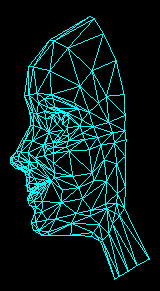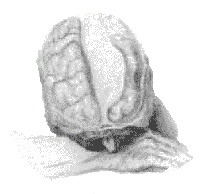
"Left-Brain, Right-Brain"
After Reading Below; (Click Here: "Create A Creative of Right Brain Intellect, Look To The Left Side For Help".
"First, Some Science"We'll keep this light and uncomplicated. Our brain, like the rest of our anatomy, is made up of two halves, a left brain a right brain. There's a big fold that goes from front to back in our brain, essentially dividing it into two distinct and separate parts. Well, almost separate. They are connected to each other by a thick cable of nerves at the base of each brain. This sole link between the two giant processors is called the corpus collosum. Think of it as an Ethernet cable or network connection between two incredibly fast and immensely powerful computer processors, each running different programs from the same input.

The left side of our body is "wired" to the right side of our brain, and vice versa. For whatever reason nature did this cross-over, it applies even to our eyes, which process a majority of their sensory data on opposite sides of the brain.
We can thank Nobel Prize Winner (1981) Roger Sperry for this next contribution. Sperry conducted what are sometimes called the "split-brain" experiments. Here's how it went: A patient suffering from uncontrolled seizures had an area of his brain removed by surgery in an attempt to control his illness. This area just happened to be the corpus collosum, which was suspected of having developed lesions (short circuits).
Following his surgery, Sperry's patient seemed completely normal -- almost. A series of tests were conducted where each "half" of the patient was isolated from the other. Different visual and tactile information could then be presented to the patient's left or right side, without the other side knowing. The results were astounding.
With their communications link severed, each side of the patient's brain was functioning independently. Although this did not prevent his ability to walk, talk and eat, some unexpected findings were encountered in some of the higher brain functions when each side was examined independently of the other.
The right hand and eye could name an object, such as a pencil, but the patient could not explain what it was used for. When shown to the left hand and eye, the patient could explain and demonstrate its use, but could not name it. Further studies showed that various functions of thought are physically separated and localized to a specific area on either the left or right side of the human brain. This functional map is consistent for an estimated 70 to 95 percent of us.
The main theme to emerge... is that there appear to be two modes of thinking, verbal and nonverbal, represented rather separately in left and right hemispheres respectively and that our education system, as well as science in general, tends to neglect the nonverbal form of intellect. What it comes down to is that modern society discriminates against the right hemisphere.
Creativity and the Right Side of the Brain
Text by
Michael P Pitek, III
The Performance Group
Where does creativity come from? How can one person be so creative and another person appear
to be uncreative? The source of creativity really stems back to the brain. Prior to the beginning of the twentieth century
little was actually known about the brain. In the late 1950's and early 1960's some significant research was conducted by
Roger Sperry. Sperry's work, which later earned him the Nobel Prize for Medicine in 1981, clearly showed that the brain is
divided into two major parts or hemispheres, the right brain and the left brain. His research also identified that each of
the parts of the brain specializes in its own style of thinking and has different capabilities.
The Left Brain
The left brain is associated with verbal, logical, and analytical thinking. It excels in naming and categorizing things, symbolic abstraction, speech, reading, writing, arithmetic. The left brain is very linear: it places things in sequential order -- first things first and then second things second, etc. If you reflect back upon our own educational training, we have been traditionally taught to master the 3 R's: reading, writing and arithmetic -- the domain and strength of the left brain.
The Right Brain
The right brain, on the other hand, functions in a non-verbal manner and excels in visual, spatial, perceptual, and intuitive information. The right brain processes information differently than the left brain. For the right brain, processing happens very quickly and the style of processing is nonlinear and nonsequential. The right brain looks at the whole picture and quickly seeks to determine the spatial relationships of all the parts as they relate to the whole. This component of the brain is not concerned with things falling into patterns because of prescribed rules. On the contrary, the right brain seems to flourish dealing with complexity, ambiguity and paradox. At times, right brain thinking is difficult to put into words because of its complexity, its ability to process information quickly and its non-verbal nature. The right brain has been associated with the realm of creativity.
|
Roger Sperry - 1973 |
Balancing a Checkbook
Take the activity of balancing your checkbook. The left brain engages in a very systematic, sequential and exact approach to getting the job done. The left brain strives for accuracy in making sure the balance balances. If the right brain were in charge of this activity, the right brain would probably be content to round up or down to the nearest dollar amount: an approach that is unacceptable to the left brain.
Driving in Traffic
Now let's consider another activity: driving on the interstate. This is clearly the domain of the right brain: spatial relationships, the ability to process information quickly, and to see the whole picture from all of the parts. If the left brain were in charge here, you would probably hear something like this: "Now the truck is approaching on the right entrance ramp at a speed of approximately 35 miles per hour, while the white sports car is approaching in the left lane, at 70 miles per hour, swerving slighting in and out of the right lane, and up ahead is a slowly moving car, traveling about 20 miles per hour, that keeps putting on its break lights every ten or fifteen seconds……" As you can tell, this style of processing information is too slow. The right brain takes over and quickly assesses what has to be done and reacts accordingly.
| This is significant because many times when a person drives a car, the left brain basically checks out and the right brain emerges as dominant. The left brain is "suspended." When this happens, many people experience some of their most creative thinking. Or how about when you take a shower?….or shaving, or jogging, or swimming? Basic repetitive actions "suspend" the left brain and "release" the right brain. |
|
The Whole Brain
As we develop our creative skills we must also develop our ability to suspend the left brain and to release the right. The ultimate goal for all of us is to approach our life and our work using a "whole" brain approach. We can't make the mistake of thinking that the left and right brains are two totally separate entities within our bodies. They are connected and do have areas of overlap. An integrated "whole" brain approach begins to maximize the untapped potential of the human brain
| Left Brain | Right Brain |
|
|
|
| Words (verbal) | Images (non-verbal) |
| Logical | Intuitive |
| Black & White | Color |
| Numbers | Rhythm |
| Sequence | Imagination |
| Analysis | Daydreaming |
| Lists | Dimension |
| Critical Thinking | Creative Thinking |
text source: This Week in Innovation
images source: U.S. National Library of Medicine
Nos. A013508, A016440
see Graphics note top.
How is the brain structured? How do the parts work together? A lot of research supports the idea that the brain has two sides. They control different modes of thinking. We need both and use both, but most humans have a preference for one side or the other. Some people, more whole-brained, are equally adept at both modes.
Personally, my right and left brains are at war with each other most of the time. My teaching style certainly appeals to the right side of your brain. Your left side finds me hopelessly disorganized and not very helpful.
This course web reflects that struggle. If I'm going to get anything done, my right brain has to take a hike. If I'm going to make any progress, it has to prevail.
I teach to your right brain to try to balance the huge prejudice that education has toward your left brain. That means more systems thinking: patterns, metaphors, analogies, role-playing, visuals. It means less true-false, multiple-choice. It also means new forms of assessment that honor right-brained talents and skills.
For example, the later presentations on Thursday night's class were stronger because of the formative, right-brain assessment that went on earlier.
Ways of Knowing
These lists extend Michael Pitek's above. They are not black and white alternatives. They are ends of a gradual continuum that I shift along. A mind map might stretch these as the diameters of a circle, place dots where my behavior falls, and gradually build a portrait of my way of knowing. Feel free to add your own ideas.
| Left Brain | Right Brain |
| intellect | intuition |
| rational | intuitive |
| rational | holistic |
| analytic | holistic |
| analytic | relational |
| analysis | synthesis |
| parts | wholes |
| sequential | intuitive |
| objective | subjective |
| logical | random |
| logical | whimsical |
| convergent | divergent |
| abstract | concrete |
| directed | free |
| propositional | imaginative |
| linear | nonlinear |
| sequential | multiple |
| successive | simultaneous |
| reasoning | mystical |
| mathematical | creative |
| speaking | visual-pictorial |
| accuracy | aesthetics |
| digital | analogic |
| dominates | submits |
| pattern user | pattern seeker |
|
Left Brain |
Right Brain |
-Roger Sperry (1973)
Upon completing the map, it was becoming clear to researchers that each side of the brain had a characteristic way that it both interpreted the world and reacted to it. The chart below will help illustrate the characteristics which are known to reside on each side of our brains.
Right Brain v Left Brain
THE Right Brain vs Left Brain test ... do you see the dancer turning clockwise or anti-clockwise?
If clockwise, then you use more of the right side of the brain and vice versa.
Most of us would see the dancer turning anti-clockwise though you can try to focus and change the direction; see if you can do it.
LEFT BRAIN FUNCTIONS
uses logic
detail oriented
facts rule
words and language
present and past
math and science
can comprehend
knowing
acknowledges
order/pattern perception
knows object name
reality based
forms strategies
practical
safe
RIGHT BRAIN FUNCTIONS
uses feeling
"big picture" oriented
imagination rules
symbols and images
present and future
philosophy & religion
can "get it" (i.e. meaning)
believes
appreciates
spatial perception
knows object function
fantasy based
presents possibilities
impetuous
risk takingAfter Reading Above; (Click Here: "Create A Creative of Right Brain Intellect, Look To The Left Side For Help".